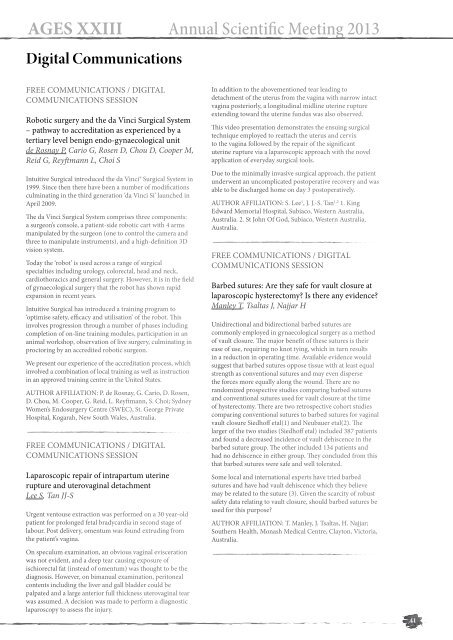AGES XXIII Annual Scientific Meeting 2013 Abstracts & Program
AGES XXIII Annual Scientific Meeting 2013 Abstracts & Program
AGES XXIII Annual Scientific Meeting 2013 Abstracts & Program
You also want an ePaper? Increase the reach of your titles
YUMPU automatically turns print PDFs into web optimized ePapers that Google loves.
<strong>AGES</strong> <strong>XXIII</strong> <strong>Annual</strong> <strong>Scientific</strong> <strong>Meeting</strong> <strong>2013</strong><br />
Digital Communications<br />
Free COMMUNICATIONS / DIGITAL<br />
COMMUNICATIONS SESSION<br />
Robotic surgery and the da Vinci Surgical System<br />
– pathway to accreditation as experienced by a<br />
tertiary level benign endo-gynaecological unit<br />
de Rosnay P, Cario G, Rosen D, Chou D, Cooper M,<br />
Reid G, Reyftmann L, Choi S<br />
Intuitive Surgical introduced the da Vinci® Surgical System in<br />
1999. Since then there have been a number of modifications<br />
culminating in the third generation ‘da Vinci Si’ launched in<br />
April 2009.<br />
The da Vinci Surgical System comprises three components:<br />
a surgeon’s console, a patient-side robotic cart with 4 arms<br />
manipulated by the surgeon (one to control the camera and<br />
three to manipulate instruments), and a high-definition 3D<br />
vision system.<br />
Today the ‘robot’ is used across a range of surgical<br />
specialties including urology, colorectal, head and neck,<br />
cardiothoracics and general surgery. However, it is in the field<br />
of gynaecological surgery that the robot has shown rapid<br />
expansion in recent years.<br />
Intuitive Surgical has introduced a training program to<br />
‘optimise safety, efficacy and utilisation’ of the robot. This<br />
involves progression through a number of phases including<br />
completion of on-line training modules, participation in an<br />
animal workshop, observation of live surgery, culminating in<br />
proctoring by an accredited robotic surgeon.<br />
We present our experience of the accreditation process, which<br />
involved a combination of local training as well as instruction<br />
in an approved training centre in the United States.<br />
AUTHOR AFFILIATION: P. de Rosnay, G. Cario, D. Rosen,<br />
D. Chou, M. Cooper, G. Reid, L. Reyftmann, S. Choi; Sydney<br />
Women’s Endosurgery Centre (SWEC), St. George Private<br />
Hospital, Kogarah, New South Wales, Australia.<br />
Free COMMUNICATIONS / DIGITAL<br />
COMMUNICATIONS SESSION<br />
Laparoscopic repair of intrapartum uterine<br />
rupture and uterovaginal detachment<br />
Lee S, Tan JJ-S<br />
Urgent ventouse extraction was performed on a 30 year-old<br />
patient for prolonged fetal bradycardia in second stage of<br />
labour. Post delivery, omentum was found extruding from<br />
the patient’s vagina.<br />
On speculum examination, an obvious vaginal evisceration<br />
was not evident, and a deep tear causing exposure of<br />
ischiorectal fat (instead of omentum) was thought to be the<br />
diagnosis. However, on bimanual examination, peritoneal<br />
contents including the liver and gall bladder could be<br />
palpated and a large anterior full thickness uterovaginal tear<br />
was assumed. A decision was made to perform a diagnostic<br />
laparoscopy to assess the injury.<br />
In addition to the abovementioned tear leading to<br />
detachment of the uterus from the vagina with narrow intact<br />
vagina posteriorly, a longitudinal midline uterine rupture<br />
extending toward the uterine fundus was also observed.<br />
This video presentation demonstrates the ensuing surgical<br />
technique employed to reattach the uterus and cervix<br />
to the vagina followed by the repair of the significant<br />
uterine rupture via a laparoscopic approach with the novel<br />
application of everyday surgical tools.<br />
Due to the minimally invasive surgical approach, the patient<br />
underwent an uncomplicated postoperative recovery and was<br />
able to be discharged home on day 3 postoperatively.<br />
AUTHOR AFFILIATION: S. Lee 1 , J. J.-S. Tan 1,2 1. King<br />
Edward Memorial Hospital, Subiaco, Western Australia,<br />
Australia. 2. St John Of God, Subiaco, Western Australia,<br />
Australia.<br />
Free COMMUNICATIONS / DIGITAL<br />
COMMUNICATIONS SESSION<br />
Barbed sutures: Are they safe for vault closure at<br />
laparoscopic hysterectomy Is there any evidence<br />
Manley T, Tsaltas J, Najjar H<br />
Unidirectional and bidirectional barbed sutures are<br />
commonly employed in gynaecological surgery as a method<br />
of vault closure. The major benefit of these sutures is their<br />
ease of use, requiring no knot tying, which in turn results<br />
in a reduction in operating time. Available evidence would<br />
suggest that barbed sutures oppose tissue with at least equal<br />
strength as conventional sutures and may even disperse<br />
the forces more equally along the wound. There are no<br />
randomized prospective studies comparing barbed sutures<br />
and conventional sutures used for vault closure at the time<br />
of hysterectomy. There are two retrospective cohort studies<br />
comparing conventional sutures to barbed sutures for vaginal<br />
vault closure Siedhoff etal(1) and Neubauer etal(2). The<br />
larger of the two studies (Siedhoff etal) included 387 patients<br />
and found a decreased incidence of vault dehiscence in the<br />
barbed suture group. The other included 134 patients and<br />
had no dehiscence in either group. They concluded from this<br />
that barbed sutures were safe and well tolerated.<br />
Some local and international experts have tried barbed<br />
sutures and have had vault dehiscence which they believe<br />
may be related to the suture (3). Given the scarcity of robust<br />
safety data relating to vault closure, should barbed sutures be<br />
used for this purpose<br />
AUTHOR AFFILIATION: T. Manley, J. Tsaltas, H. Najjar;<br />
Southern Health, Monash Medical Centre, Clayton, Victoria,<br />
Australia.<br />
41
















